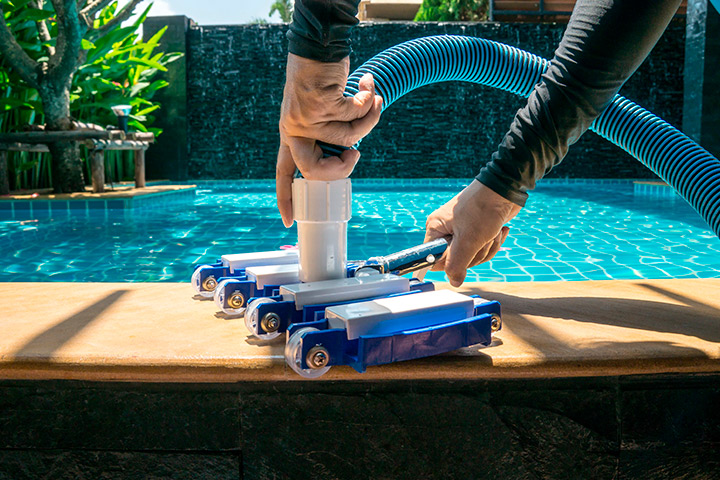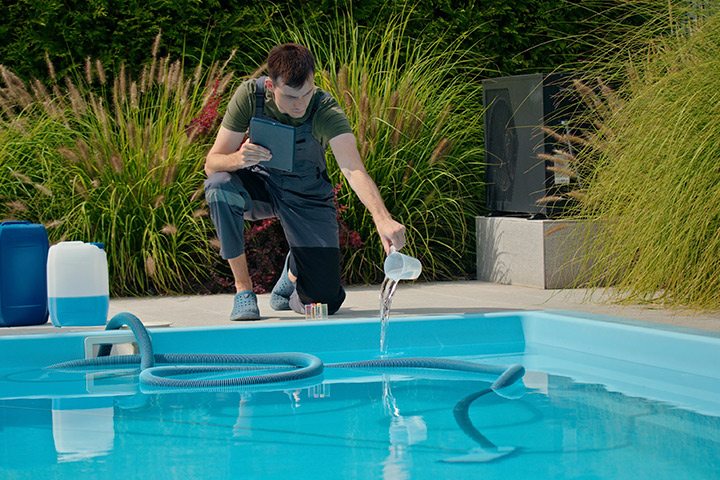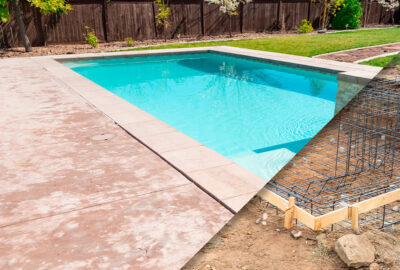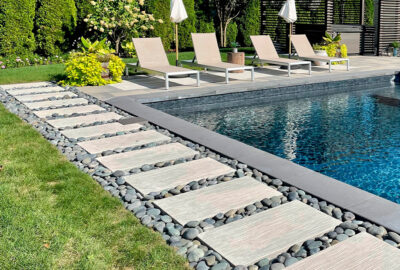
Dive into Pristine Waters: 7 Essential Pool Maintenance Tips for Austin Homeowners
For Austin homeowners, a swimming pool is a welcome retreat from the city’s notorious hot weather. With temperatures regularly soaring above 90°F for nearly four months of the year, your backyard oasis becomes prime real estate for relaxation and recreation. But maintaining that crystal-clear water requires more than occasional attention, especially given Austin’s unique climate challenges.
Our city’s weather pattern of hot, oppressive summers followed by mild winters, punctuated by occasional storms and high winds, creates specific maintenance demands for pool owners. The intense Texas sun accelerates chlorine breakdown, while sudden downpours can quickly dilute carefully balanced chemicals and introduce contaminants. Without proper pool maintenance, these conditions can transform your refreshing retreat into a murky, problematic headache.
Regular maintenance is about both aesthetics and protecting your investment. It prevents costly repairs and helps preserve safe swimming conditions for your family and guests. In this guide, we’ll explore seven essential pool maintenance tips specifically tailored for Austin homeowners, helping you navigate our city’s climate peculiarities while keeping your water pristine year-round.
1. Establish a consistent cleaning schedule

Austin’s hot, oppressive summers combined with a wet season from late April to mid-September create the perfect storm for pool maintenance challenges. Establishing a regular pool cleaning routine is your first line of defense against these challenging conditions. Here is what your schedule should include:
- Regular Debris Removal: Austin’s landscape means leaves, pollen, and outdoor debris constantly find their way into your pool. Daily skimming prevents these materials from sinking, decomposing, and clogging your filtration system. During fall and after storms, increase frequency to prevent overwhelming buildup.
- Weekly Deep Cleaning: Beyond daily skimming, dedicate time each week for thorough brushing and vacuuming. Brush walls and tiles to prevent algae buildup and vacuum the pool floor to remove settled particles. This weekly routine prevents the stubborn stains and growth that thrive in Austin’s warm water conditions.
- Year-Round Consistency: While it’s tempting to reduce maintenance during cooler months, Austin’s mild winters and unpredictable weather patterns mean your pool needs attention all year. Consistent cleaning prevents chemical imbalances, protects equipment from unnecessary strain, and guarantees your pool remains swim-ready whenever those surprise warm days arrive.
Remember that establishing this routine is about extending your pool’s lifespan and reducing the need for costly repairs or chemical treatments down the line.
2. Monitor and balance pool chemicals
Preserving proper chemical balance is essential in Austin’s climate, where hot summers and fluctuating rainfall can quickly throw off your pool’s chemistry. Regular monitoring prevents algae growth, equipment damage, and supports safe swimming conditions.
- Test essential levels weekly: Monitor pH (aim for 7.2-7.8), chlorine (1-3 ppm), and alkalinity (80-120 ppm) at least once a week. During Austin’s peak summer months (June-September), when temperatures consistently exceed 90°F, consider testing twice weekly as heat accelerates chlorine depletion.
- Address Austin’s hard water challenges: Central Texas has notably hard water with high calcium levels. This affects chemical balance and can lead to scaling on pool surfaces and equipment. Test calcium hardness quarterly (aim for 200-400 ppm) and use sequestering agents when necessary to prevent staining and equipment damage.
- Adjust after weather events: Heavy rainfall dilutes chemicals and introduces contaminants while altering pH levels. After storms, which are more common from April to September in Austin, retest your water and adjust accordingly.
- Prevent biological growth: Improper chemical balance creates the perfect environment for algae and bacteria, especially in Austin’s heat. These organisms can turn water cloudy or green, cause unpleasant odors, and potentially lead to health issues for swimmers.
3. Optimize pool Equipment for longevity
Your pool’s equipment works overtime in Austin’s demanding climate, where summer temperatures regularly soar above 90°F and even winter brings fluctuating conditions. Proper equipment maintenance not only prevents costly breakdowns but also guarantees your pool operates efficiently year-round.
- Inspect and clean filters, pumps, and skimmers regularly: Backwash or rinse filters at least monthly, and clean skimmer baskets weekly. Clogged filters force your system to work harder, increasing energy costs and reducing effectiveness. During peak summer months, check these components more frequently as debris accumulation accelerates.
- Check for leaks and unusual noises in equipment: Inspect pump seals, pipe connections, and equipment pads monthly for water accumulation or dampness, indicating leaks. Listen for grinding, screeching, or rattling sounds when your equipment runs, as these are early warning signs of mechanical problems. Address these issues promptly to prevent them from leading to complete system failure.
- Schedule professional equipment inspections – Even with diligent DIY maintenance, have a licensed pool technician in Austin perform thorough equipment evaluations at least twice yearly. Austin’s unique water conditions and climate extremes create specific challenges that professionals are trained to identify. These experts can spot potential issues before they become emergencies and recommend efficiency upgrades when appropriate.
4. Address algae and stains promptly

Austin’s hot, sunny climate creates perfect breeding conditions for pool algae. With temperatures regularly exceeding 90°F for months at a time, staying ahead of these unwelcome visitors is essential.
Identify common Austin pool algae:
Understanding what you’re dealing with is the first step in combating algae effectively, especially in a region where multiple types may appear throughout the season.
- o Green algae: Most common, appears as floating particles or wall coatings during hot summer months
- o Mustard/yellow algae: Resembles pollen or sand, often returns without thorough treatment
- o Black algae: Forms stubborn root systems in cracks and porous surfaces, particularly difficult to eliminate
Use effective removal techniques:
Once you’ve identified the type of algae, choosing the right method to treat it is key to preventing recurring outbreaks.
- o Test and balance water chemistry before treatment (pH between 7.2–7.6)
- o Use algaecide specifically formulated for the type of algae present
- o Brush pool surfaces vigorously to loosen algae from walls and floor
- o Vacuum debris after brushing to remove dead algae cells
Implement aggressive treatment for persistent problems:
For algae that resists standard treatments, taking a stronger approach can help restore your pool’s health and clarity.
- o Apply chlorine shock treatment during evening hours (UV rays break down chlorine faster during daytime)
- o Run filtration system continuously for 24–48 hours after treatment
- o Consider professional treatment for stubborn black algae infestations
- o Follow up with preventative maintenance and regular testing
5. Maximize water levels and circulation
- Regulate proper water levels year-round. Austin’s intense heat causes pools to lose approximately a quarter of an inch of water daily through evaporation. Keep water at the midway in the skimmer opening; too low and you risk damaging your pump; too high and your skimmer loses efficiency. If levels drop more than 1.75 inches weekly, investigate for potential leaks rather than just refilling.
- Check circulation components regularly. Confirms jets and returns are functioning properly and aimed correctly to create a gentle circular flow. Clean skimmer baskets weekly and inspect for clogs or obstructions that might impede water movement. Proper circulation distributes chemicals evenly and helps your filtration system work efficiently, reducing the need for excessive chemical treatments.
- Prevent stagnation to combat algae growth. In Austin’s warm climate, stagnant water quickly becomes a breeding ground for algae and bacteria. Running your pump at least 8-10 hours daily promotes consistent water movement, especially during the hottest months when algae thrives in sunlight and warm temperatures. Consider upgrading to energy-efficient variable-speed pumps that provide optimal circulation while reducing electricity costs.
6. Prepare for Austin’s seasonal changes

- Summer Intensification (June-September): Increase chemical testing to twice weekly during Austin’s hottest months when temperatures consistently exceed 90°F. Chlorine depletes up to 35% faster due to UV photolysis, requiring more frequent additions. Top off water levels more frequently to combat evaporation, which can reach a quarter inch daily during peak summer.
- Storm Readiness (Most Common April-September): Lower water levels by 1-2 inches before predicted heavy storms to prevent overflow. Cover your pool when possible, to minimize debris and contamination. After storms, rebalance chemicals immediately, rain typically dilutes chlorine and alters pH levels, creating perfect conditions for algae growth..
- Winter Preparation (November-February): While Austin rarely experiences prolonged freezes, prepare for occasional cold snaps by protecting exposed pipes and equipment. Support circulation during cold weather to prevent freezing, even with reduced filtration hours. Consider a professional winterization service when temperatures are predicted to drop below freezing for extended periods.
7. Know when to call a professional pool technician in Austin
Even with diligent maintenance, certain pool issues require expert intervention. Knowing when to call a professional can save you time, money, and frustration in Austin’s challenging climate.
- Recognize these warning signs: Persistent cloudy water despite chemical treatments, unusual noises from equipment, unexplained water loss (more than 1.75 inches weekly), visible cracks or damage to pool surfaces, recurring algae problems, or equipment that won’t start or run properly. These issues often indicate underlying problems that require professional diagnosis.
- Benefits of professional servicing: Licensed technicians bring specialized knowledge about Austin’s water conditions and climate challenges. They have access to professional-grade tools and chemicals, can identify problems before they escalate, and often save you money through preventative maintenance. Most importantly, they keep your pool safe for swimmers.
- Choosing the right service provider: Look for companies with specific experience in Austin pools, proper licensing and insurance, transparent pricing, and positive customer reviews. Ask about their response time for emergencies, particularly during storm season when many pools need attention simultaneously.
Enjoying a sparkling pool year-round
Achieving a pristine pool in Austin’s challenging climate requires vigilance and consistency. Our city’s unique weather patterns, from scorching summers to unexpected storms, create specific demands on pool chemistry, equipment, and overall care. By implementing these seven essential maintenance practices, you’ve taken important steps toward protecting your investment while ensuring your backyard oasis remains ready whenever you are.
Consistent upkeep is necessary to create a safe, inviting environment for family and friends while protecting one of your property’s most valuable features. Clear water and functioning equipment translate to peace of mind, allowing you to enjoy your pool rather than worry about it.
If you find yourself struggling to keep up with maintenance demands or facing persistent issues, remember that professional help is available. Enjoy a pristine pool without the hassle. Contact Aspire Pools & Outdoors who offers comprehensive pool maintenance services tailored for busy Austin homeowners. Our expert team keeps your pool swim-ready through weekly cleaning, precise water chemistry balancing, and thorough system inspections. Spend less time stressing over maintenance, and more time diving into pristine, worry-free waters. Let us handle the hard work so you can enjoy every splash.




